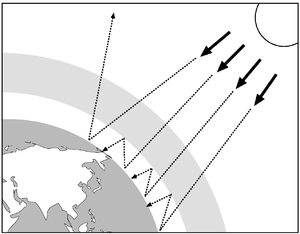Difference between revisions of "The greenhouse effect and global warming"
(Add in nav template, pic) |
|||
| Line 4: | Line 4: | ||
[[File:GreenhouseEffectDiagram01.png|300px|left|Diagram showing the [[greenhouse effect]]]] | [[File:GreenhouseEffectDiagram01.png|300px|left|Diagram showing the [[greenhouse effect]]]] | ||
| + | ;Questions | ||
| + | # If the greenhouse effect did not exist, what would the normal temperature of the earth be? | ||
| + | # What do you think is meant by global warming? | ||
| + | # List all the things you can think of that give off greenhouse gases – eg cars. | ||
| + | |||
| + | ==Looking at the data== | ||
| + | ===Temperature changes over the last century=== | ||
| + | |||
| + | Study the graphs, published by the International Panel of Climate Change (IPCC) and then answer the questions. | ||
| + | These are temperatures above and below the average for the period 1961–1990. | ||
| + | |||
| + | For more information see the [http://www.epa.gov/climatechange/science/recenttc.html USAEPA website]. | ||
[[Category:ChemSpider Education]] | [[Category:ChemSpider Education]] | ||
Revision as of 18:47, 11 August 2010
| For teachers |
|---|
| This content is for teachers |
| For students |
| This content is for students |
| For technicians |
| This content is for technicians |
A garden greenhouse keeps plants warmer than they would be outside. It does this because the glass traps some of the Sun’s radiation energy. The atmosphere keeps the Earth warm in a similar way. Without the greenhouse effect the earth would be about 33 °C cooler than today’s pleasant average of 15 °C. Greenhouse gases include carbon dioxide, oxides of nitrogen, methane, chlorofluorocarbons (CFCs) and water.
- Questions
- If the greenhouse effect did not exist, what would the normal temperature of the earth be?
- What do you think is meant by global warming?
- List all the things you can think of that give off greenhouse gases – eg cars.
Looking at the data
Temperature changes over the last century
Study the graphs, published by the International Panel of Climate Change (IPCC) and then answer the questions. These are temperatures above and below the average for the period 1961–1990.
For more information see the USAEPA website.
